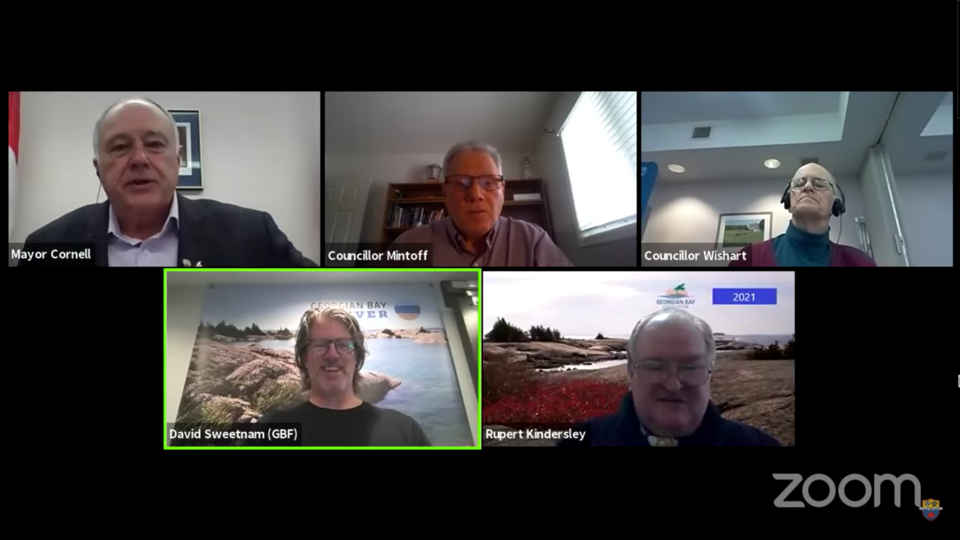Disagreement levels between shoreline residents and organizations studying water continue to rise like the waters of Lakes Huron and Michigan.
Rupert Kindersley, executive director of Georgian Bay Association (GBA) and David Sweetnam, executive director of Georgian Bay Forever (GBF), recently reached out to MidlandToday to rebut the statements made in a presentation by Frank Dunnigan, a Tiny Township resident.
Sweetnam said that Dunnigan, whose property is literally getting washed into Georgian Bay, has a legitimate concern and cause for obvious alarm that GBF and GBA share.
"We understand what's going on," said Sweetnam, adding, "we would like to have a real conversation and offer real solutions."
However, he said, part of the issue lies in the way the general public and residents understand the matter and use information to approach various levels of government.
"When we are making a presentation, we've pulled in the official departments agencies and credited experts that feed into those processes, said Sweetnam. "The problem with this issue is that the public and the capacity to understand the nuances is difficult."
He referenced a couple statements made by Dunnigan in his presentation to council following a presentation made by GBF/GBA.
"He's putting up quotes from the International Lake Superior Board of Control to rebut the statement that the board has put out about its balancing principle applications," said Sweetnam, reiterating he supports Dunnigan's cause for alarm.
"He says, 'the board expects the total outflow to be 2,530 cubic metres per second in December, which is a 110 cubic metres per second more than that prescribed by Lake Superior Regulation Plan 2012.' What he doesn't include is that the source document says they expected a slight additional increased inflow to offset expected and potential unscheduled reductions in flow at the hydro power plant there," he said.
Addressing the specifics of Dunnigan's statement, Sweetnam said that even if you put in an increased flow of 110 cubic metres per second into Lakes Michigan-Huron, they would only rise by 0.09 inches.
"It's insignificant," he said, adding, "Blaming the IJC is a waste of time; we're not going to solve the problem by doing that."
Sweetnam said the problem is cherry-picking lines.
"(Dunnigan) just makes a statement as a statement of fact: that therefore, see, they're lying to you," he said.
Sweetnam said, the problem is also around how Dunnigan's statements were reported verbatim.
"We're not here to undermine Mr. Dunnigan and his concerns because we share them," he said. "This is a challenge with trying to educate the public on an issue. That's why it's absolutely key that the authoritative sources be the sources that are published, not un-authoritative hyperbolic statements that don't provide a fact base. That creates a whole problem."
Sweetnam further said Dunnigan's use of the Levels Reference Study done by the International Joint Commission is based on incomplete information.
"There's a document that feeds into that process that is an analysis of how far you could push every one of the diversions, how far you could push those, and if they would useful or not," said Sweetnam. "We had the U.S. Army Corps present that data at our symposium and the impacts about are about cumulatively 3 inches of impact. That's insignificant because it's not enough to address the current concerns that Mr. Dunnigan has about the water level being at 12 inches above where he would like them to be at peak."
The Levels Reference Study, he said, also had not taken into account the impacts of climate change. The follow-up to it, Plan 2012 did so to some degree, but the recommendations don't give it enough weight, added Sweetnam.
"We need to stop focusing on these 'actions the IJC isn't taking under the recommendations,'" he said. "They're outdated."
The immediate solutions, he said, will be presented at another GBF and GBA symposium this October.
"This is a conversation we need to have very seriously," he said. "We know all water-related businesses and municipalities and residents are affected. And that's what we want to talk about in October and bring in experts so the public can get some advice."
Kindersley said that's because the situation needs to be addressed as it is, not how someone would like it to be.
He talked about Dunnigan's claim that his property is set back at least 20 feet from the township's high-water marks.
"There is a major problem with these high water marks," said Kindersley, "in that, official plans and bylaw, all need to be reviewed. They no longer apply. The historical information we're getting is that there's going to need to be some major revision at some point for these high water marks."
At this point, Sweetnam said, the remedies will have to be reactive and adaptive.
The long-term solutions, he said, can only come forward once the Environment Canada report on water levels is shared with the public.
Even with that, Kindersley said organizations need to exercise caution.
"Even the forecasts are at best a probability rating of what's expected in the future," he said. "It's important for people to understand that you can have these forecasts, however, the weather isn't always as you expect it to be."
The GBF and GBA have also offered a 12-point action plan they aim to take up with governments and other authorities in the future. The document outlining their course of action can be found online.
